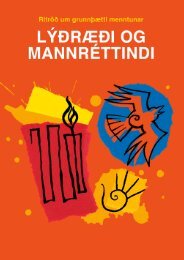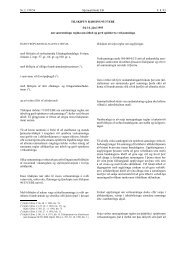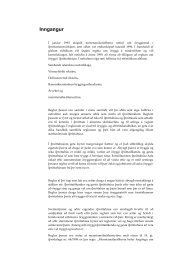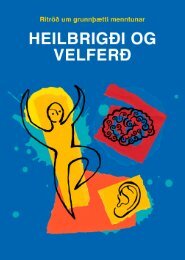Arts and Cultural Education in Iceland : Professor Anne Bamford
Arts and Cultural Education in Iceland : Professor Anne Bamford
Arts and Cultural Education in Iceland : Professor Anne Bamford
You also want an ePaper? Increase the reach of your titles
YUMPU automatically turns print PDFs into web optimized ePapers that Google loves.
Chapter 1: Introduction <strong>and</strong> overview<br />
1.1 Introduction<br />
In 2008-09 an impact evaluative research was undertaken <strong>in</strong> Icel<strong>and</strong> to gather<br />
comprehensive data about the extent <strong>and</strong> quality of arts <strong>and</strong> cultural education <strong>in</strong> Icel<strong>and</strong>. The<br />
evaluation focused on the follow<strong>in</strong>g questions:<br />
1. What is be<strong>in</strong>g done <strong>in</strong> arts education <strong>and</strong> how is it be<strong>in</strong>g done?<br />
2. What is the quality of arts education <strong>in</strong> Icel<strong>and</strong>?<br />
3. What are the possibilities <strong>and</strong> challenges currently <strong>and</strong> <strong>in</strong>to the future?<br />
These questions were addressed through the use of an <strong>in</strong>tensive six month study us<strong>in</strong>g a<br />
comb<strong>in</strong>ation of qualitative <strong>and</strong> quantitative research methods. The report is organised <strong>in</strong> a way<br />
that starts from def<strong>in</strong>itions of terms <strong>and</strong> the nature of practices. The research analyses the<br />
implementation framework of arts <strong>and</strong> cultural education <strong>and</strong> identifies factors that <strong>in</strong>fluence<br />
the adoption of best practice <strong>in</strong> arts <strong>and</strong> cultural education.<br />
The focus of the research was on both formal <strong>and</strong> non-formal provisions of arts <strong>and</strong> cultural<br />
education. In the context of Icel<strong>and</strong>, this <strong>in</strong>cludes arts <strong>and</strong> cultural education with<strong>in</strong> schools <strong>and</strong><br />
also the activities completed by children <strong>in</strong> a range of after school possibilities, <strong>in</strong>clud<strong>in</strong>g music<br />
schools, arts schools, local theatres <strong>and</strong> museums <strong>and</strong> other providers. The research also<br />
<strong>in</strong>vestigated provisions <strong>in</strong> nursery years <strong>and</strong> for children with special learn<strong>in</strong>g needs.<br />
Implementation issues were also explored, <strong>and</strong> a focus was given to teacher education <strong>and</strong> the<br />
professional development of both teachers <strong>and</strong> artists. The research also exam<strong>in</strong>ed the<br />
economic dimensions of the creative <strong>and</strong> cultural <strong>in</strong>dustries <strong>in</strong> the context of recent, broader<br />
changes political <strong>and</strong> economic conditions <strong>in</strong> Icel<strong>and</strong>.<br />
This research is l<strong>in</strong>ked to the <strong>in</strong>ternational evaluation of arts education conducted <strong>in</strong> 2006<br />
for UNESCO 1 <strong>and</strong> mirrors the subsequent <strong>in</strong>-depth country studies conducted <strong>in</strong> Denmark,<br />
Fl<strong>and</strong>ers <strong>and</strong> The Netherl<strong>and</strong>s. To build a benchmarked set of knowledge, complementary<br />
methods have been used for these studies <strong>and</strong> the same framework has been applied to data<br />
gather<strong>in</strong>g <strong>and</strong> analysis of themes to enable <strong>in</strong>ternational comparisons to be made.<br />
1.2 Scope<br />
The research was led by <strong>Professor</strong> <strong>Anne</strong> <strong>Bamford</strong>, Director of the Eng<strong>in</strong>e Room at University<br />
of the <strong>Arts</strong>, London. Dur<strong>in</strong>g the <strong>in</strong>-country study, the M<strong>in</strong>istry of <strong>Education</strong>, Science <strong>and</strong> Culture<br />
provided logistical support. Jón Hrólfur Sigurjósson provided contextual leadership, translation<br />
<strong>and</strong> document <strong>and</strong> policy <strong>in</strong>terpretation.<br />
The research commenced <strong>in</strong> October 2008 <strong>and</strong> the data gather<strong>in</strong>g was completed <strong>in</strong> March<br />
2009. In total, 214 people were <strong>in</strong>terviewed <strong>and</strong>/or participated <strong>in</strong> focus groups <strong>and</strong> 47 schools<br />
<strong>and</strong> organisations were visited. The participants came from all stakeholder sectors <strong>and</strong> <strong>in</strong>cluded<br />
civil servants, politicians, school pr<strong>in</strong>cipals, teachers, cultural coord<strong>in</strong>ators, <strong>in</strong>dustry<br />
representatives, cultural <strong>in</strong>stitutions, students, artists, teacher educators, professors,<br />
performers, members of the media, parents <strong>and</strong> the museum <strong>and</strong> gallery sector. An <strong>in</strong>ternetbased<br />
survey was sent to all schools – <strong>in</strong>clud<strong>in</strong>g ‘after school schools’ <strong>in</strong> Icel<strong>and</strong> to gather<br />
1 <strong>Bamford</strong>, A (2006) The Wow Factor: Global research compendium on the impact of arts <strong>in</strong> education. Waxmann, Műnchen.<br />
11



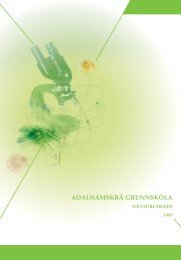
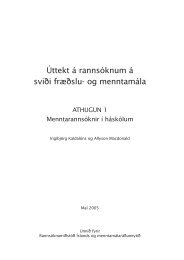

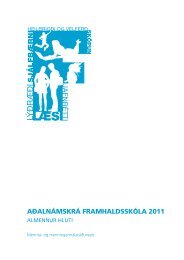
![Aðalnámskrá tónlistarskóla : rytmÃsk tónlist [Eingöngu á rafrænu formi]](https://img.yumpu.com/50843672/1/184x260/aaalnamskra-tanlistarskala-rytma-sk-tanlist-eingangu-a-rafranu-formi.jpg?quality=85)
